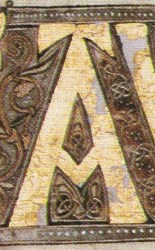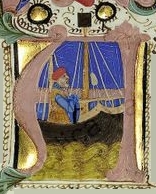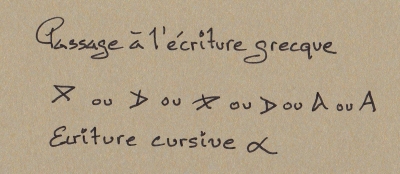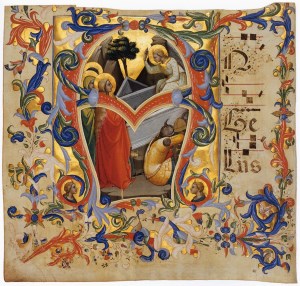 |
 |
 |

Codex Aureus 8th century
Probably executed in Canterbury
Here are some excerpts from "Voice Spoken and Sung" by Carine Klein-Dallant, Speech Therapist, in: Use of Vowels in the Practice
of Rehabilitation of the Voice by Dr. Nicole Charpy, Phoniatre.
The position of the A is obtained from the rest position by opening slightly the jaw, while keeping the tongue flattened
(the edges of the tongue in contact with the inner edge of the teeth). This creates a space of the entire anterior and median
part of the mouth. While the posterior part the tongue is bombed backwards and downwards, narrowing the pharyngolaryngeal die ... The larynx has a tendency to descend.
The soft palate can behave in two ways:
The a anterior (in 'papa' in french): the a is clear and slamming, the veil rises in its middle under the effect of the azygos
muscle, forming an gothic ogive.
The a posterior (in 'âme' in French), called throat, corresponds to a rather inert median veil, the tightening taking place by
a bringing together of the pillars of the veil ...

The Psalter of Jean de Berry
(between 1386 and 1400).
National Library of France
Informations from 'Introduction to phonetics of French, by Fernand Carton, Bordas', p 48.
| Formants | F1 | F2 | F3 |
| a anterior | 660 | 1350 | 2380 Hertz |
| ɑ posterior | 620 | 1150 | 2250 Hertz |

French gothic tiny writing 1396
♦ The A, first letter of the alphabet Western, drift of the first protosinaitic letter of the alphabet which is
represented by a bull.
The bull is named Alpu in Akkadian, aleph in phoenician and in the Semitic languages.
According to Marc-Alain Ouaknin, in the mysteries of the alphabet, edited Assouline:
The bull is the first sign, because he represents "the strength", the energy useful for life, for the agriculture, for the transport; essential energy which puts the being in movement, which makes pass of the being in existence.
- Egyptian hieroglyph(- 3000):
The drawing of the bull already exists in the Egyptian hieroglyph.

The drawing of the bull is the determinant of 'cattle'. Most Egyptian words are endowed, following the phonetic signs used to
write them, with a determinative indicating the semantic category to which these words belong.


This fragment of water clock dates from the Ptolemaic era (around 330 BC).
This is the royal cartouche containing the name 'Alexander' written from right to left.
It shows how the a is represented.
- Protosinaitic inscriptions(-1500):
The bull is then reduced to its head alone, with mouth and eye or without. This is the graphical form found on Protosinaitic inscriptions.


Protosinaïtic inscriptions
Very quickly, the drawing of the head is simplified and becomes:

But most often:


Protosinaïtic inscriptions
- Passage to Greek writing(-800):
The Aleph becomes alpha and always presents itself with the stroke of the head and the two horns. But the alpha has changed direction. :

The Greek alpha in cursive writing is written with the horns turned to the right.
- Then in Etruscan (-800; - 700), Latin (- 600) and the European alphabet (3th century):

♦ In Hebrew:
Passage of Aleph (Xth century BC) to the new form of classical Hebrew from the 1st century BC.: א, which derives Aramean forms.

In the cursive writing of Hebrew, the aleph kept its original form. The two horns of the bull are visible. The letter has been
rotated 90°.
♦ In Arabic:
A : Alif is the first letter of the Arabic alphabet. Normally, it is only the support of the sign hamza.
 |
 |
| Letter Alif | Hamza |

Missal of Cardinal Jean Rolin XVIth S
According to Carine Klein-Dallant, Speech therapist, in spoken Voice, sung voice p 81 :
- The A approaches the expression of the giggle, of the laughter counterfeited (at the time which the jaw between open lets appear them
teeth).
- The yawn in its expiratory time is rather vocalized on an A.
- It is also the vowel of fright, the cry of rage, the open-mouthed fear, open-mouthed crying. Emotions during which the jaw is open and the mouth especially for the fright is in square.
- We also find the fearful surprise and unexpected pain
- Here we find the tonic and aggressive character of this vowel, obviously turned towards the interlocutor in a relationship of self-assertion.
- Dame Sarrasine, Speech Therapist, adds: the extended indicating the satisfaction after a wait.

Piero di Giovanni named Lorenzo Monaco
monk, painter and illuminator(1370-1425)
museum of Louvre-Paris

Writing of Arthur Rimbaud

Letter A
Creation of Dame Sarrasine.
